Siemens commissions gas-to-energy project; Veolia and Oxford Flow improve pressure in mobile units; Tesco joins WDBC
Siemens commissions gas-to-energy project
Siemens announced the commissioning of two SGE-56HM gas engines that are providing environmentally friendly electrical power for a landfill gas-to-energy project at Southern Idaho Solid Waste’s (SISW) Milner Butte Landfill in Burley, Idaho. Siemens’ gas capture engines are helping to convert 1,000 tons of landfill waste daily into energy.
Decomposing waste gives off massive amounts of greenhouse gases, especially methane. SISW engineers worked with Siemens and Siemens’ channel partner, Industrial-Irrigation Services, to develop a solution that would capture the methane for use as a fuel gas to produce electricity. To capture methane and convert it into electricity, the Milner Butte Landfill deployed two Siemens SGE-56HM gas generator sets to run on the waste gas from the landfill and generate electrical power. Once the landfill gas is converted to electricity, it is transported to Idaho Power through a 20-year purchase agreement and is used by the community as a low-cost source of power.
Siemens SGE-HM series is purpose-built for landfill gas-to-energy power applications. By incorporating advanced technology and design into the cylinder heads, valves, camshafts, and turbochargers, the SGE-56HM engine provides customers like SISW with a high-performing low-operating-cost solution.
Veolia and Oxford Flow pair up to improve pressure control in mobile units
To address water pressure regulation and head loss in its on-site purified water services from purpose-built HGV trailers — supplied to industrial processors and plants in Europe — Veolia turned to Oxford Flow, a manufacturer of pressure control equipment. Veolia needed to regularly manage large pressure drops, which meant having two pressure reducing valves (PRVs) to reduce the pressure over two stages. The problem: The two separate products added up to more than 100 kilograms of equipment on its trailers, which reduced portability and increased the weight of the trailers. It needed a provider to help it develop and deploy a more mobile and accurate solution for hydrant PRV assemblies.
The rugged, lightweight design of Oxford Flow’s products allowed for easy adjustment of the set pressure as well as control of the speed of response. This made it quicker and more efficient to set up and deliver precisely controlled pressure and flow exactly to the customer specifications. With Oxford Flow’s products, Veolia was able to streamline its infrastructure from two PRVs weighing some 60 kilos each to just one PRV weighing around 25 kilos. As a result, it had a more efficient solution that could reduce from a high pressure in just one stage.
Tesco Controls joins Water Design-Build Council
The Water Design-Build Council (WDBC), a not-for-profit organization dedicated to collaborative delivery methods for water infrastructure projects, invited Tesco Controls Inc. (TESCO) to join its organization. This is the first time the WDBC has invited a system integrator to join the council. Representing TESCO as an allied member on the WDBC board of directors is Brian Adams, P.E., director of design-build projects. Prior to joining TESCO, Adams was a civil and mechanical contractor. He then began practicing as a P.E. in various roles at national and global consulting firms focused on water and wastewater projects. Most recently, Adams was a key team member of the water design-build sales group for a multinational firm that designs and constructs water and wastewater treatment plants.
